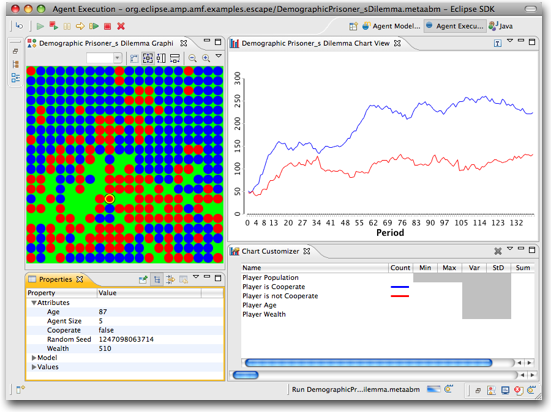Notice: this Wiki will be going read only early in 2024 and edits will no longer be possible. Please see: https://gitlab.eclipse.org/eclipsefdn/helpdesk/-/wikis/Wiki-shutdown-plan for the plan.
Difference between revisions of "AMP/UserGuide/Escape"
(Redirecting to AMP/UserGuide/Escape/Overview) |
|||
| Line 1: | Line 1: | ||
| − | + | =Escape Overview= | |
| + | |||
| + | Escape is a full-featured Agent-Based Modeling (ABM) integrated development environment (IDE) with a Java based API and end user modeling tools. It's based on Ascape, which has been in use for more than 10 years. The core API is very stable, and that should give users a way to explore the features of AMP without concerns about keeping in synch with the rapidly evolving AXF /AGF API. It allows modelers to code in Java and/or generate models with AMF and then execute those models within the same development environment. | ||
| + | |||
| + | [[image:AMPScreenshot.png]] | ||
| + | |||
| + | A primary purpose of the Escape project -- apart from the obvious goal of providing a nice Eclipse hosted ABM toolkit -- is to provide an exemplar to demonstrate how any arbitrary agent modeling framework can be integrated within the AMP environment. A cool aspect of this is that AMP has no dependencies on Escape, but also that the underlying ABM modeling framework for Escape has no dependencies on AMP -- instead Escape simply provides the runtime glue between AMP and the ABM framework. The underlying ABM framework uses the Ascape API, an API that first began development more than ten years ago and that has not been modified at all in order for it to work within the AMP environment. | ||
| + | |||
| + | (Well, not quite.. Ascape was refactored into separate non-UI core and a Swing UI projects. This involved a bit of repackaging, but was really straightforward as Ascape follows a strict MVC architecture. Note that currently Escape is bulkier than it will eventually be -- over time we will be generalizing more aspects of Escape into the AMP AXF and AGF components.) | ||
| + | |||
| + | ==Using Escape== | ||
| + | |||
| + | ===[[AMP/UserGuide/Escape/Getting Started|Getting Started]]=== | ||
| + | |||
| + | ===Documentation and other Resources=== | ||
| + | |||
| + | Because it's API is based on Ascape, Escape is one component of AMP that already has extensive documentation. There is complete Javadoc as well as a manual and other web resources. See the [http://ascape.sourceforge.net Ascape Website] to locate these resources. The documentation on the main page is a good place to start. It's written for Ascape so ignore all of the bits about project setup, and a lot of the UI is different, but the basics apply to Escape just as well. The [http://ascape.sourceforge.net/docs/TheAscapeManual5.pdf Ascape Manual] written by Damon Centola should be very helpful. Take a look at the conversion link below for ideas on how to make the models form the manual work under Ascape. (Converting these models is a great opportunity for a community contribution!) | ||
| + | |||
| + | ===Reference=== | ||
| + | |||
| + | [[AMP/UserGuide/Escape/Converting From Ascape|Converting Ascape Models to Escape]] | ||
Revision as of 22:00, 14 December 2009
Contents
Escape Overview
Escape is a full-featured Agent-Based Modeling (ABM) integrated development environment (IDE) with a Java based API and end user modeling tools. It's based on Ascape, which has been in use for more than 10 years. The core API is very stable, and that should give users a way to explore the features of AMP without concerns about keeping in synch with the rapidly evolving AXF /AGF API. It allows modelers to code in Java and/or generate models with AMF and then execute those models within the same development environment.
A primary purpose of the Escape project -- apart from the obvious goal of providing a nice Eclipse hosted ABM toolkit -- is to provide an exemplar to demonstrate how any arbitrary agent modeling framework can be integrated within the AMP environment. A cool aspect of this is that AMP has no dependencies on Escape, but also that the underlying ABM modeling framework for Escape has no dependencies on AMP -- instead Escape simply provides the runtime glue between AMP and the ABM framework. The underlying ABM framework uses the Ascape API, an API that first began development more than ten years ago and that has not been modified at all in order for it to work within the AMP environment.
(Well, not quite.. Ascape was refactored into separate non-UI core and a Swing UI projects. This involved a bit of repackaging, but was really straightforward as Ascape follows a strict MVC architecture. Note that currently Escape is bulkier than it will eventually be -- over time we will be generalizing more aspects of Escape into the AMP AXF and AGF components.)
Using Escape
Getting Started
Documentation and other Resources
Because it's API is based on Ascape, Escape is one component of AMP that already has extensive documentation. There is complete Javadoc as well as a manual and other web resources. See the Ascape Website to locate these resources. The documentation on the main page is a good place to start. It's written for Ascape so ignore all of the bits about project setup, and a lot of the UI is different, but the basics apply to Escape just as well. The Ascape Manual written by Damon Centola should be very helpful. Take a look at the conversion link below for ideas on how to make the models form the manual work under Ascape. (Converting these models is a great opportunity for a community contribution!)

